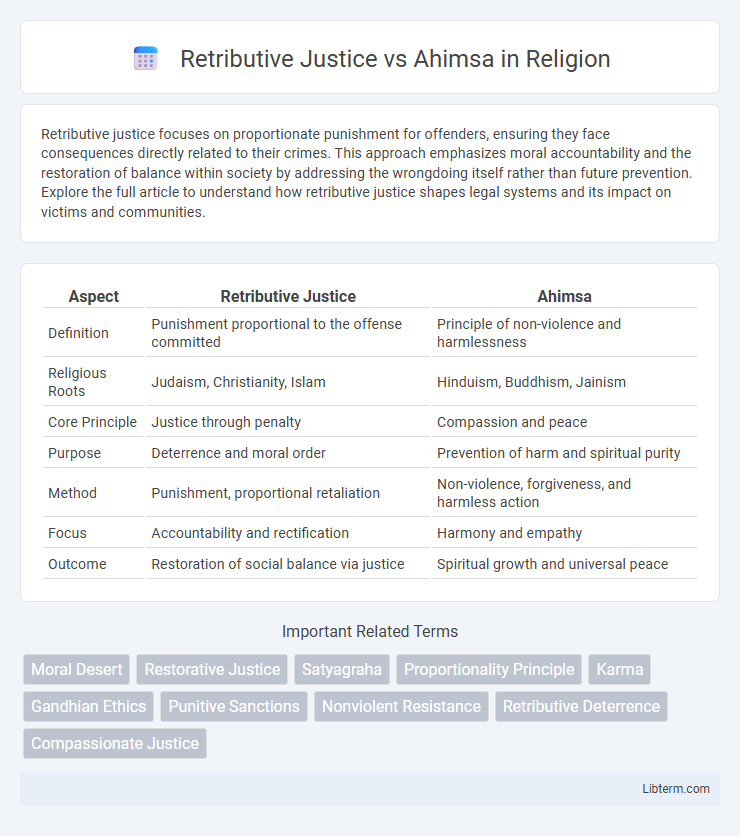Retributive justice focuses on proportionate punishment for offenders, ensuring they face consequences directly related to their crimes. This approach emphasizes moral accountability and the restoration of balance within society by addressing the wrongdoing itself rather than future prevention. Explore the full article to understand how retributive justice shapes legal systems and its impact on victims and communities.
Table of Comparison
| Aspect | Retributive Justice | Ahimsa |
|---|---|---|
| Definition | Punishment proportional to the offense committed | Principle of non-violence and harmlessness |
| Religious Roots | Judaism, Christianity, Islam | Hinduism, Buddhism, Jainism |
| Core Principle | Justice through penalty | Compassion and peace |
| Purpose | Deterrence and moral order | Prevention of harm and spiritual purity |
| Method | Punishment, proportional retaliation | Non-violence, forgiveness, and harmless action |
| Focus | Accountability and rectification | Harmony and empathy |
| Outcome | Restoration of social balance via justice | Spiritual growth and universal peace |
Understanding Retributive Justice: Principles and Origins
Retributive justice is a theory focused on proportionate punishment, grounded in the principle that offenders deserve consequences equivalent to their wrongdoing, originating from ancient legal codes such as Hammurabi's Code and classical Western philosophy. Its core principles emphasize moral culpability and the balance of justice through penalties that correspond to the severity of the offense. Retributive justice contrasts sharply with Ahimsa, a principle of non-violence rooted in Indian philosophy advocating for compassion and harm avoidance in response to wrongdoing.
The Philosophy of Ahimsa: Nonviolence Explained
Ahimsa, rooted in ancient Indian philosophy, promotes nonviolence as a fundamental ethical principle, emphasizing compassion and respect for all living beings. Unlike retributive justice, which seeks punishment proportional to wrongdoing, Ahimsa advocates for resolving conflict through peaceful means, forgiveness, and rehabilitation. This philosophy influences major religions like Jainism, Buddhism, and Hinduism, shaping a moral framework that prioritizes harm reduction and harmony over vengeance.
Historical Evolution of Retributive Justice Systems
Retributive justice has evolved from ancient legal codes such as Hammurabi's Code and the lex talionis principle, which emphasized proportionate punishment as a societal deterrent. Historically, this system focused on balancing scales of justice through penalties matching the offense, often involving corporal or capital punishment. In contrast, Ahimsa, rooted in Indian religions like Jainism and Buddhism, advocates non-violence and forgiveness, challenging the traditional retributive emphasis on punishment.
Ahimsa in Eastern Philosophies and Religions
Ahimsa, a core principle in Eastern philosophies such as Hinduism, Buddhism, and Jainism, emphasizes non-violence and compassion towards all living beings, contrasting sharply with the punitive nature of retributive justice. Rooted in ancient texts like the Bhagavad Gita and the Jain Agamas, Ahimsa advocates for resolving conflicts through forgiveness and understanding rather than punishment. This ethical approach influences legal and moral frameworks in Eastern societies, promoting restorative justice and societal harmony over retribution.
Core Differences: Retributive Justice vs Ahimsa
Retributive justice centers on punishment proportional to the offense, emphasizing accountability and deterrence through legal or moral sanctions. Ahimsa, rooted in nonviolence and compassion, rejects harm and seeks resolution through forgiveness and reconciliation. The core difference lies in retributive justice aiming for punitive measures, while Ahimsa prioritizes peace and healing without causing suffering.
Ethical Implications of Punishment vs Compassion
Retributive justice emphasizes punishment proportional to the offense, underscoring accountability and justice for victims, often raising ethical concerns about perpetuating harm and cycle of violence. Ahimsa, rooted in nonviolence and compassion, challenges punitive measures by advocating for healing and restoration over retribution, promoting moral responsibility to reduce suffering. The ethical implications of punishment versus compassion hinge on balancing societal order with empathetic approaches that prioritize rehabilitation and respect for all beings.
Case Studies: Societies Shaped by Retribution or Nonviolence
Japan's post-World War II legal reforms showcase retributive justice by emphasizing accountability and punishment for war crimes, reinforcing societal order through strict legal consequences. In contrast, India's independence movement led by Mahatma Gandhi exemplifies Ahimsa, where nonviolent resistance shaped a societal commitment to peace and reconciliation, influencing restorative justice practices. These case studies highlight how societies structured around retribution or nonviolence develop distinct cultural, legal, and social frameworks that impact their approach to conflict resolution and justice.
Modern Justice Systems: Retributive or Transformative?
Modern justice systems often lean towards retributive models that emphasize punishment proportional to the offense, aiming to uphold societal order and deter crime. In contrast, Ahimsa-inspired transformative justice prioritizes nonviolence and healing, seeking to address root causes of wrongdoing and restore relationships rather than imposing punitive measures. Emerging restorative practices in some jurisdictions reflect this shift, promoting rehabilitation and community involvement over strict retribution.
Challenges in Applying Ahimsa in Legal Frameworks
Applying Ahimsa, the principle of non-violence, within legal frameworks poses significant challenges due to the inherent reliance of traditional retributive justice systems on punishment and deterrence. Legal systems prioritize accountability through penalties, which often conflict with Ahimsa's emphasis on compassion, forgiveness, and restorative approaches. Integrating Ahimsa requires transformative legal reforms that balance societal protection with non-violent, healing-based justice models.
Toward a Balanced Approach: Reconciling Justice and Nonviolence
Retributive justice emphasizes punishment proportionate to the offense, aiming to restore moral order and deter wrongdoing, while Ahimsa advocates nonviolence and compassion even toward wrongdoers. A balanced approach integrates accountability with restorative practices that promote healing and reconciliation, minimizing harm to all parties involved. Embracing restorative justice models rooted in Ahimsa principles can transform punitive systems into frameworks focused on empathy and societal harmony.
Retributive Justice Infographic

 libterm.com
libterm.com